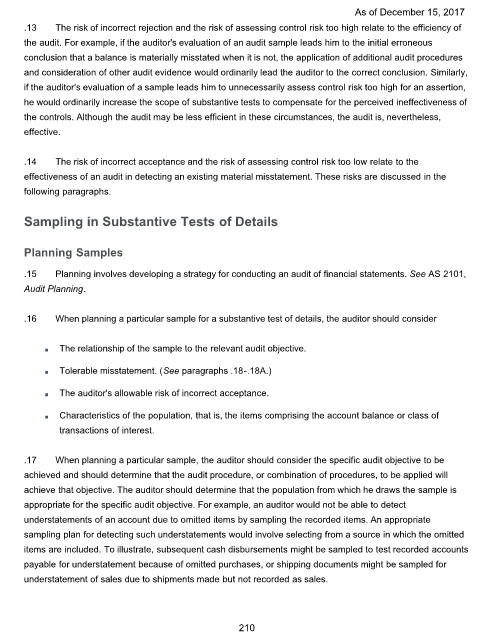Page 213 - Auditing Standards
P. 213
As of December 15, 2017
.13 The risk of incorrect rejection and the risk of assessing control risk too high relate to the efficiency of
the audit. For example, if the auditor's evaluation of an audit sample leads him to the initial erroneous
conclusion that a balance is materially misstated when it is not, the application of additional audit procedures
and consideration of other audit evidence would ordinarily lead the auditor to the correct conclusion. Similarly,
if the auditor's evaluation of a sample leads him to unnecessarily assess control risk too high for an assertion,
he would ordinarily increase the scope of substantive tests to compensate for the perceived ineffectiveness of
the controls. Although the audit may be less efficient in these circumstances, the audit is, nevertheless,
effective.
.14 The risk of incorrect acceptance and the risk of assessing control risk too low relate to the
effectiveness of an audit in detecting an existing material misstatement. These risks are discussed in the
following paragraphs.
Sampling in Substantive Tests of Details
Planning Samples
.15 Planning involves developing a strategy for conducting an audit of financial statements. See AS 2101,
Audit Planning.
.16 When planning a particular sample for a substantive test of details, the auditor should consider
The relationship of the sample to the relevant audit objective.
Tolerable misstatement. (See paragraphs .18-.18A.)
The auditor's allowable risk of incorrect acceptance.
Characteristics of the population, that is, the items comprising the account balance or class of
transactions of interest.
.17 When planning a particular sample, the auditor should consider the specific audit objective to be
achieved and should determine that the audit procedure, or combination of procedures, to be applied will
achieve that objective. The auditor should determine that the population from which he draws the sample is
appropriate for the specific audit objective. For example, an auditor would not be able to detect
understatements of an account due to omitted items by sampling the recorded items. An appropriate
sampling plan for detecting such understatements would involve selecting from a source in which the omitted
items are included. To illustrate, subsequent cash disbursements might be sampled to test recorded accounts
payable for understatement because of omitted purchases, or shipping documents might be sampled for
understatement of sales due to shipments made but not recorded as sales.
210

